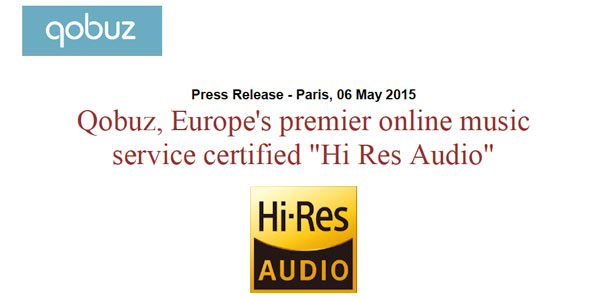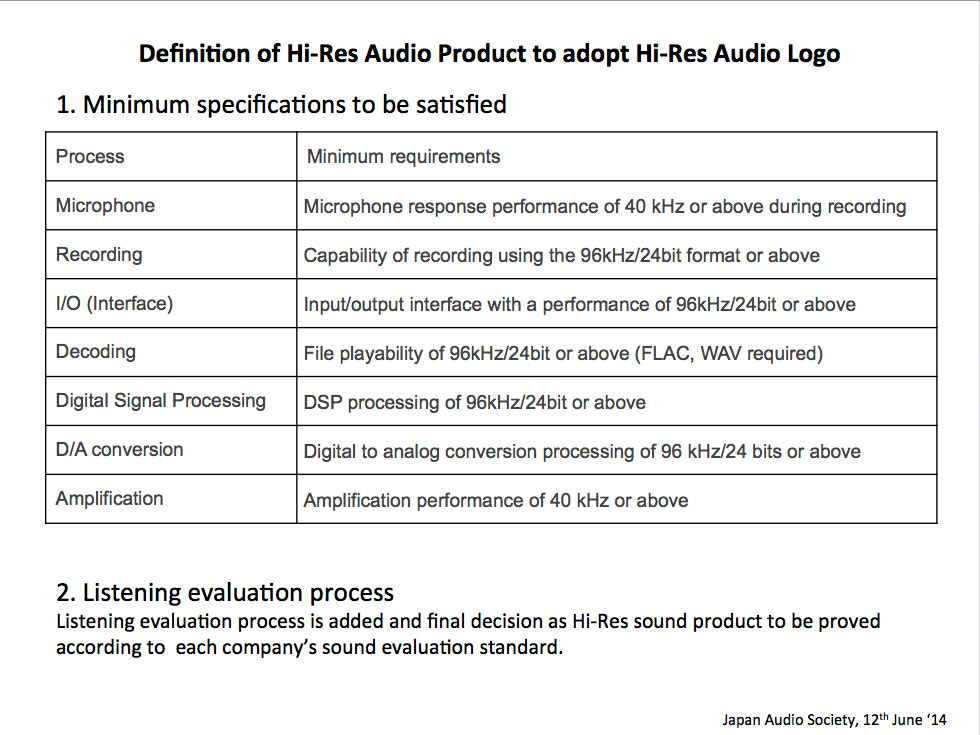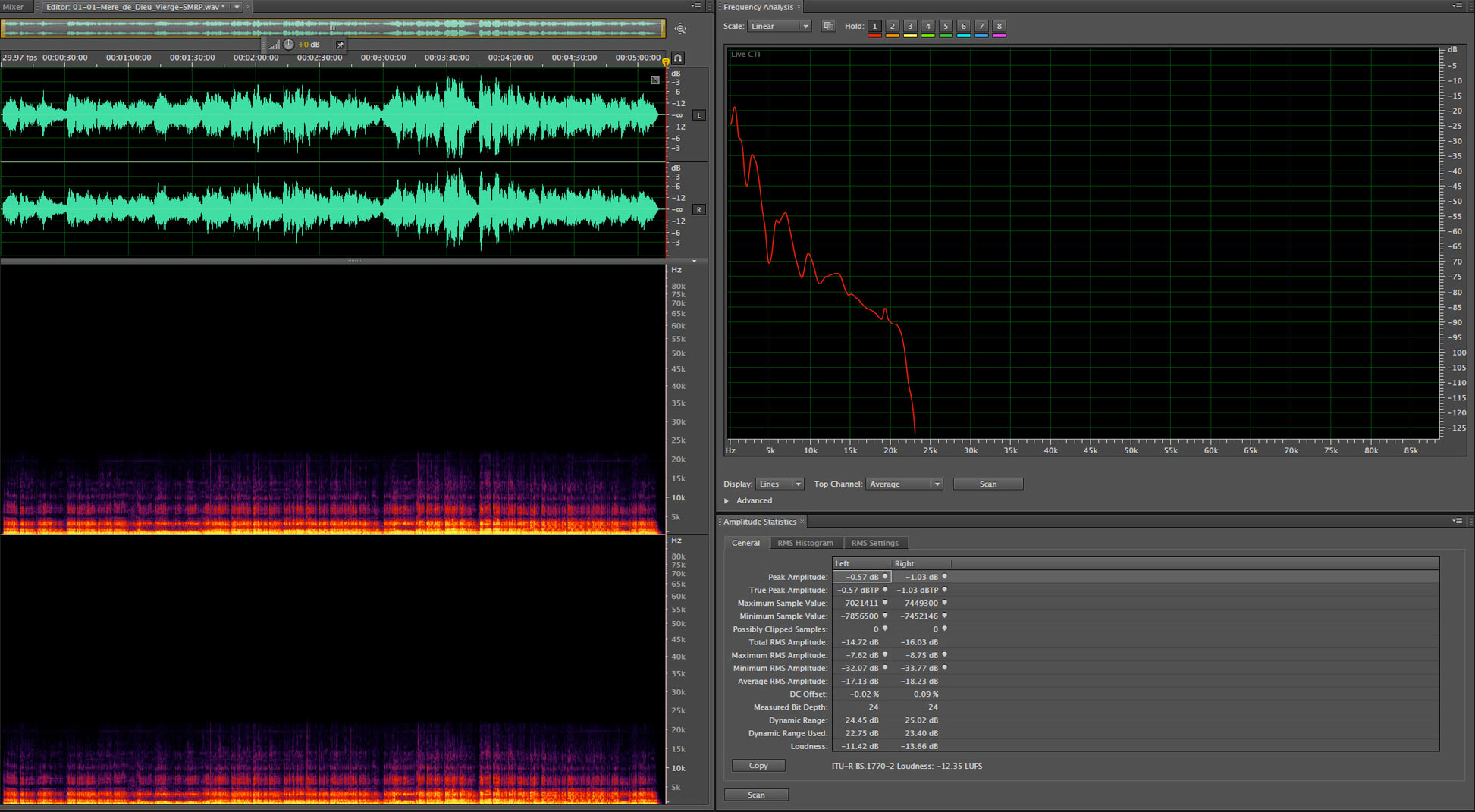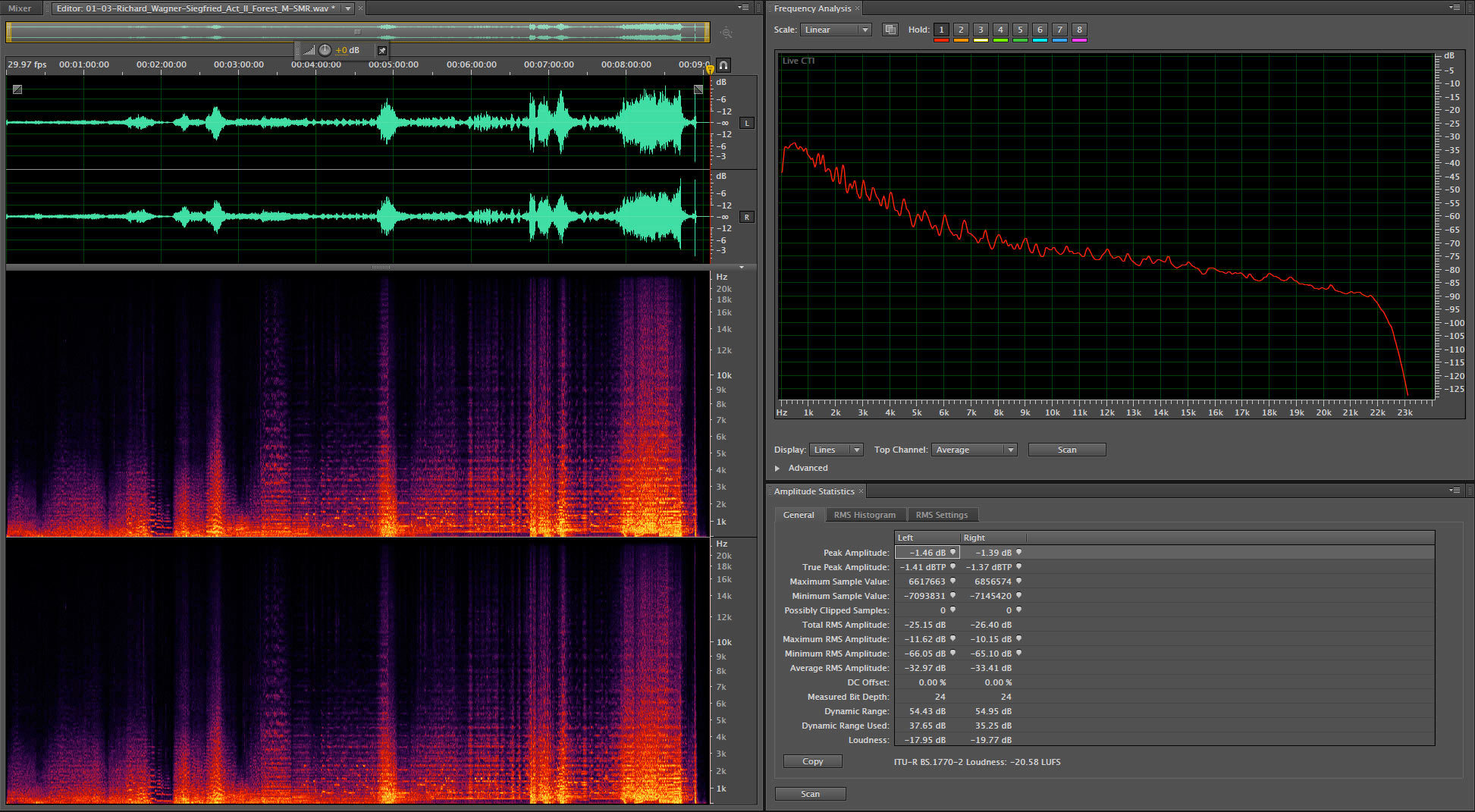Qobuz, the JAS, and the Myth of the High-Res Audio Logo
One of the largest “high-resolution” music download sites in the world (so they claim) is the French site Qobuz. I had some back and forth with them a year or more over their claim to have a high-resolution catalog available only to discover that they are doing what just about everyone else does. The recordings are standard definition catalog recordings transferred to larger bit buckets. The Gustavo Dudamel recording of a Wagner work proudly displayed the JAS (Japan Audio Society’s) High-Res Audio logo but proved to be no better than a CD. You can read my post about this deception by clicking here.
In a May 5, 2015 recent press release, Qobuz announced, “Qobuz, Europe’s premier online music service certified ‘Hi Res Audio’ – The premier online music service in France has become the first and only service in Europe to obtain the ‘Hi-Res Audio’ certification from the prestigious Japan Audio Society, a Japanese association of audio material producers.” Just how they managed to get certified, as a source of high-resolution without meeting the requirements set forth by the JAS is a troubling question. In fact, it baffles me. I’ve been counting on the JAS to uphold their rigorous requirements as the best path forward against the meaningless definition issued by the DEG, CEA, NARAS, and major labels.
The release also includes a statement from the chairman of the JAS. He states, “We are pleased to license the Hi-Resolution Audio (HRA) logo developed and administered by Japan Audio Society (JAS) to Qobuz. We, JAS, are acting to advance Hi-Resolution Audio together with JAS member companies. It is a very important milestone to apply the same HRA logo used on hardware to the digital music service of Qobuz, as we believe that it is the best way for customers to coordinate hardware and software. We hope very much that the distribution of Hi-Resolution Music continues to grow with Qobuz”.
They have licensed the High-Res Audio logo to Qobuz. But the JAS isn’t in the business of checking whether a site or a company actually meets the specifications. They specifically absolve themselves from any responsibility by including the following on their “Definition of Hi-Res Audio Products” document. “Listening evaluation process is added and final decision as Hi-Res sound product to be proved according to each company’s sound evaluation standard.”
What does that mean? It means the Qobuz can say that they’re releasing content that meets the JAS standards but they are the company responsible for evaluating the content as to whether it is high-res or not.
How much confidence should we have that anything has changed because the “High-Res Audio” logo is prominently displayed on the Qobuz site? None. In spite of the press release’s assurances, “The Hi-Res Audio (HRA) logo is a guarantee of respect for the high standards put in place by the JAS consortium – to which the largest global electronics manufacturers and the biggest music labels have all subscribed.” The fact is no such guarantee of respect can exist if the content doesn’t measure up.
Here’s the requirements document as provided by the JAS:
Figure 1 – The JAS requirements for using the “high-res audio” logo. [Click to enlarge]
Notice the requirement that the audio recorder be able to do 96 kHz/24-bits. Analog tape doesn’t meet this requirement…therefore any items on the Qobuz website that originated on analog tape shouldn’t be able to display the logo. But the site doesn’t seem to know that. Here are a couple of spectra from Qobuz that were advertised as examples of “high-resolution” audio. They aren’t.
Figure 2 – A download from Qobuz. This track has no audio content above 24 kHz and a dynamic range of about 25 dB…or 5 bits! [Click to enlarge]
Figure 2 – Another track from Qobuz with the same issue. This track is no better than a CD but they display the JAS logo next to it.
I wrote to the chairman of the JAS today about this issue. I don’t expect any response.





Troubling when public domain companies “police” themselves. Just ask shareholders of Lehman Bros. what they think of the SEC. Qobuz was purportedly on the brink of bankruptcy. Has JAS facilitated a self promoting “poster child”, corrupting their otherwise empty basket ? Words are cheap when absolution is free, and so becomes, “shameless” audio.
one of these days please do write a post on how to read and analyse these audio related graphs which you frequently post.
I wrote a whole series of posts on how to read a spectragraph. Here’s a couple of links:
How To Read A Spectragram: Part I
How to Read a Spectragram: Part II
Hi Mark,
This is really sad, but of course more of the same, and we know by now the commitment to quality that we can hold QOBUZ by, as well as the respect they have for their customers regarding the product they advertise and what they actually sell. Especially considering the ridiculous responses they gave you the last time you showed their HRA Guarantee is moot.
Nevertheless, I think that if customers can have access to an App that verifies the quality of tracks, this would certainly put some pressure on them, and at least they could file suit for false advertisement. The development of such an App would be a welcome tool for analyzing the quality of the downloads bought from any site. The use of more complicated and expensive software is not going to favor the customers checking that what they got is what they paid for. I wonder if you could get behind the creation of such and App, and with a couple of other features, such as measurements of Dynamic Range.
I have a couple of hundreds of 24bit downloads, many from much before I found your blog and got to read about the whole HRA debacle, and dozens from QOBUZ. I remember when I first got them, I was skeptic, but I gave it a try, and relied on the comments and hype of other websites and the classic HIFI magazines we all know.
Back then I got to ask questions such as: How much of a HRA recording is above 20kHz; which instruments are capable of producing material above 20kHz; how substantial is that material really to our audition and what our gear can reproduce, and is it really worth the extra money (almost double the price)? But I had not much knowledge to rely on, and it took me quite a bunch of your posts and articles to get more informed.
Today I appreciate all I have learned from reading REAL HD-AUDIO every day, and I can barely imagine my day without reading your daily posts, but I can understand that other music consumers have less time and motivation to work themselves through understanding what is behind sample rates and bit depths, the difference between PCM and DSD (I also fell for a couple of DSD downloads), and the recent definitions adopted and legitimized by DEG, CEA, NARAS, the JAS standard, etc. I think that having a tool that allowed consumers to do a quick quality check would help a lot, and I think an App would come in very handy, as well as make it very difficult for QOBUZ and the likes to get away with their BS. If high ranking professionals like yourself appear to have little influence, and certainly no leverage against businesses like QOBUZ, maybe consumers will have, since it’s their money they depend on. Any thoughts?
Cheers!
Thanks Camilo…I appreciate your support.
It’s the typical sort of faux accreditation you see in so many industries. Created with the intent of making companies and their products more credible, when in fact it’s all available to anyone willing to pay the fee. That this particular “accolade” seems self policing should pour further derision on its existence.
What a disappointing mess the HRA game has quickly become. Smoke and mirrors everywhere.
I guess I shouldn’t be surprised…it is all about business.
This is indeed disheartening news. I had hoped that the JAS would actively work to ensure that anyone wanting to use their logo was indeed meeting the requirements of the standards as stated by the JSA.
It is almost like putting up speed limit signs on all roads but never providing funds to police departments to enforce the rules. Why bother?
Querido amigo, me parece que las grandes empresas discograficas están mas empeñadas en seguir exprimiendo los viejos catálogos, mas que nada, para la música portatil, que en invertir en nuevas grabaciones en Alta Resolución desde el principio. Lo peor es el engaño de la gente que cree que compra algo superior a un cd y no es así. Saludos y gracias por seguir aclarando ideas.
Gracias Federico!
Perhaps, we should all write to the JAS chairman.
I think that’s a great idea. You can write to the JAS at this address. jas@jas-audio.or.jp
The biggest mistake that Neil Young made with the Pono was pricing it too low which lost the interest of the elitist crowd. How anyone who is supposedly an objective reviewer can continue to diss the product without having ever done a critical listening test (and I don’t mean at a show!) is beyond me. But keep believing…
I have a friend that has offered me the use of his Pono player…her referred to it as a “doorstop”. I’m looking forward to getting my hands on one. It think Charles did a great job with the constraints of a portable handheld player. I’ve heard a Pono on several occasions but never had one hear at the studio.
I just did that!!!
Greetings
FB
Hi Mark,
The first line of the minimum spec says that the microphone needs to be >40 kHz capable – if this doesn’t show on spectra then it’s not HRA – full stop. If you think this is a valid point I will write to JAS.
I mentioned exactly the same thing in my response to an email I received from the JAS. The told me that their “definition” applies only to hardware.
If the JAS Hi-Res logo only applies to hardware, how can it be applied to recordings by companies such as Qobuz?
Here is a quote form the CEA and JAS announcement “The Hi-Res Audio logo, which currently is only available for use by JAS members, will be offered to CEA member companies via a licensing agreement with JAS for use in product promotion, advertising and merchandising efforts. In support, CEA will promote the HRA logo at the 2015 International CES®, produced by CEA, and throughout the coming year. CEA and logo licensees agree to follow the HRA product guidelines and performance requirements, as specified by JAS.”
http://www.ce.org/News/News-Releases/Press-Releases/2014/CEA-and-Japan-Audio-Society-to-Collaborate-on-Hi-R.aspx
1) This announcement specifies that the JAS specification for HRA will be used when the JAS Hi-Res logo is applied to a product.
2) This announcement specifies that “logo licensees agree to follow the HRA product guidelines and performance requirements”
If the JAS HRA specification does not apply to recordings, then use of the JAS Hi-Res logo does not apply to recordings, and the logo cannot be applied to recordings.
I will now be sending a second email to JAS, asking how the JAS Hi-Res logo can be applied to a product when the JAS HRA specification is not applicable to the product.
Very helpful…good points.
It may simply refer to the fact that Qobuz offers streaming that can support 24-bit/96 kHz content without any downsampling. In that case, it’s the service that gets the logo, not the music.
Maybe…but they’ve placed the logo on specific product pages.
If the microphones are only capturing audio within CD quality limits (44.1 kHz) then wouldn’t they only record information that a CD can already playback? What would be the need for hi-res headphones, speakers, DSPs, etc., if the microphones are capturing the sounds at 40 kHz? (In regards to music made from performances, not electronica).
There are microphones that exceed 20 kHz…in fast, most do with increasing attenuation as the frequency rises.
The majority of the information in this article is rooted in a profound ignorance of the facts surrounding what Hi-Res is and thus serves only to misinform the market and slow down progress. You’re mixing hardware, software and particular recordings absolutely everywhere here. There is an evident misunderstanding on your part between the frequency spectrum which is technically attainable in high definition formats and the frequency spectrum of real instruments and vocals, which is obviously more limited. Having tested these albums myself I can assure they are most certainly in line with the definition of what Hi-Res audio is. You may do well to brush up on your facts before delving into a detailed analysis that is riddled with errors.
Seamus, thanks for your comments. The JAS did respond to my email and told me that they’re allowing the logo to be used in conjunction with hardware that meets their requirements BUT can be licensed to sites like QoBuz adhering to a much lower set of requirements…those of the DEG, NARAS, CEA, and record labels. This creates a world in which we can have very good equipment but standard-resolution tracks parading as high-resolution…like the examples that I peeled off of QoBuz.
I’m very confident in my assessment of the way the high-resolution audio world is using false marketing to resell old masters. The head of R&D at Harman International and the format head of the Audio Engineering Society agrees with me…so I’m not sure who’s ignorant of the facts.
The increased frequency spectrum allows higher musical partials to be accurately captured…and yes, instruments and voices are not “limited” to the range of 20-20kHz. Having tested these albums? Using what process? Your ears?
I’ve been involved in high-resolution audio for over 15 years. I have produced and engineered many dozens of high-resolution titles, given keynotes on the topic, and serve on committees at the CEA, NARAS, and AES. You can define high-resolution any way you like, but the fact remains that QoBuz and other High-Res download sites are only delivering the quality of the original source masters.
I am fairly saddened by the vehemence in this post, even if it was posted several months ago and is old news. I believe you might have a bone to pick, and are you choosing argument to make Qobuz look like an unscrupulous actor – which I feel is pretty far from the truth.
As full disclosure, I used to work at Qobuz, and some my opinion is probably biased in some way. Back when I was there, our fight was to legitimize and make standard CD quality downloads (and then streaming) at a time where everybody was peddling 128 kbps. It was an uphill battle, and we often called charlatans back then. Now, thankfully, CD quality is more less an acquired right – or at least 320 kbps quality.
The problems we encountered then are, I assume, the same they are encountering now: we are at the end of a very long chain, with many different actors, some willfully unscrupulous, some unwittingly stupid. We were largely at the mercy of what suppliers delivered us. I can’t tell you how may times we got recordings that were “high def” but in fact truncated and then “upsampled” – sometimes this was an honest mistake in the postprocessing chain; sometimes it was someone trying to sell us master’s more expensively.
We ended up having to be in the habit of scrupulously double-checking as many of the daily deliveries as we could (and you might not realize but this is an extremely time consuming job).
Nowadays, most music distributors work the same way: they get delivered the raw unprocessed digital masters from the publisher, and then store those as is. Some people believe nobody is interested in these masters as they are, but the belief was that if the music is available in a certain quality, there should be the option for the consumer to purchase it untouched. That is the idea behind the “Hi-Res” nomenclatura.
However unfortunately, as you note, there isn’t yet a clear standard of what Hi-Res is, and it depends of how the music was recorded.
To answer the other points your raise:
— are some of the recordings on the site not at the definition that they are advertised? yes, and when I was there (and I assume still now) every day was a renewed fight against such and such provider for sending substandard files;
— is hi-res a gimmick or something that is actually worth something? that is another question, I don’t have a definitive answer, but for me, when you go to a concerthall, there is some physical effort (what I call “chills”) that can not be duplicated by CD recordings. With a good enough material I feel I have been able to recover this feeling with high res files… but maybe that’s just a placebo effect.
When you see that Spotify has many albums with tracks that are actually truncated in length (i.e. I’ve seen 10′ tracks which stop after less than half a seconds), you realize that other providers are having more trouble, and less scruples than Qobuz.
(By the way, you mention the quality problems with audio files. But all of this is true with all the other aspects of music: the metadata in the files, which is regularly a big mess, and which we were trying to clean up; and the booklet, which we fought to get, and even now Qobuz sometimes doesn’t, and sometimes gets a substandard booklet, or one in a weird format. These are all part of the same issues.)
It’s nice to get an insider view of Qobuz, thanks for the information. I do know how challenging it is to validate “high-res” music. I do have a bone to pick with any site that pretends that standard-resolution audio recordings can rightfully labeled as High-Res with the wave of marketing keystroke. However, in the case with Qobuz, both of the free samples that were supposed to clearly demonstrate the magic of high-res music…weren’t high-res at all. And the response I got from the company was to deny the obvious.
I’m not cutting anyone any slack. I wrote once again about the fraud of PonoMusic today. Just tell the truth and everything would be much better.
It would be nice if:
– you published the link of the audio excerpts which you are analyzing;
– you published the response you got from the company.
This would prove that you are actually keeping them to task, rather than giving elements which are hardly verifiable by anybody else.
(Admittedly the filenames are in the screenshots you give, but I can’t find them on their site.)
I can do that if the free samples are still there. I did publish all this stuff back when I posted the article.
Jared, I posted the spectra of the tunes…I honestly don’t know if the same files are being provided for free any longer. I also published the responses from the representative from Qobuz and the producers of the two falsely labeled downloads.